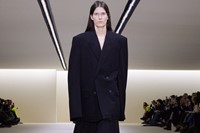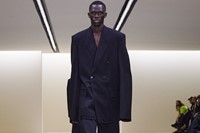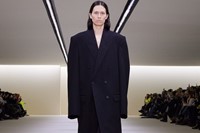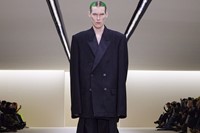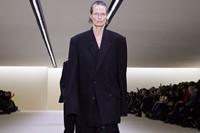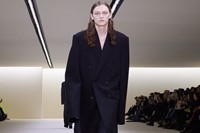A couple of days before his Autumn/Winter 2023 Balenciaga show, Demna is in a reflective mood. Reflecting not only on the past few months of his life, since the furore surrounding their Gift Shop advertising campaign rained down, but on his career as a designer over the past few years.
It’s rare to be invited into Balenciaga’s headquarters – a 17th-century former hospital on the Left Bank of Paris – to view clothing ahead of a fashion show. Unique, even. But, this season, the clothes are the sole focus. Eschewing vast sets and multi-million euro productions, the Balenciaga show wasn’t so showy, pitched in a plain white space wrapped entirely with canvas, used to create toiles, the shadows of clothes to come. So, the show was literally staged on the foundation of fashion – and furthermore, it was held (albeit with maximum security) in the bowels of the Carrousel du Louvre, a cavernous convention space specifically built for fashion shows and opened in 1993. It was abandoned by most designers in the late 90s, and officially ditched in 2010. You couldn’t have picked a more fashionable location.
Which was precisely the point. The direction – to pull emphasis from grand statements, and switch attention back to the grit of the clothes – is something Demna says has been bubbling for a while. “Doing the mud show in October, I already knew,” he states, referencing the Spring/Summer 2023 show where models clambered around a pit of dirt in a film studio outside of Paris. “I was extremely frustrated. We worked for six months on the collection, and you don’t see it. The clothes are completely overshadowed by this mega-production. Which I love doing. But the clothes vanished.” And, for any designer, that would be a problem. “I felt almost like I betrayed myself, somehow. So the mud show was a climax of that. I needed to go back to what nourishes me, creatively.”
What nourishes Demna is not the cultural statements to be made with pyrotechnic set design – where clothes become players, but certainly not the whole message. Rather, he says, it is the very mechanics of designing. He recounted to me, a few hours after his debut Balenciaga show some seven years ago, that his working process involves not sketching, nor mood-boarding, but working physically with garments, cutting and repositioning. “I always start with a garment, and then I cut. I destroy so many clothes. To make more clothes.”
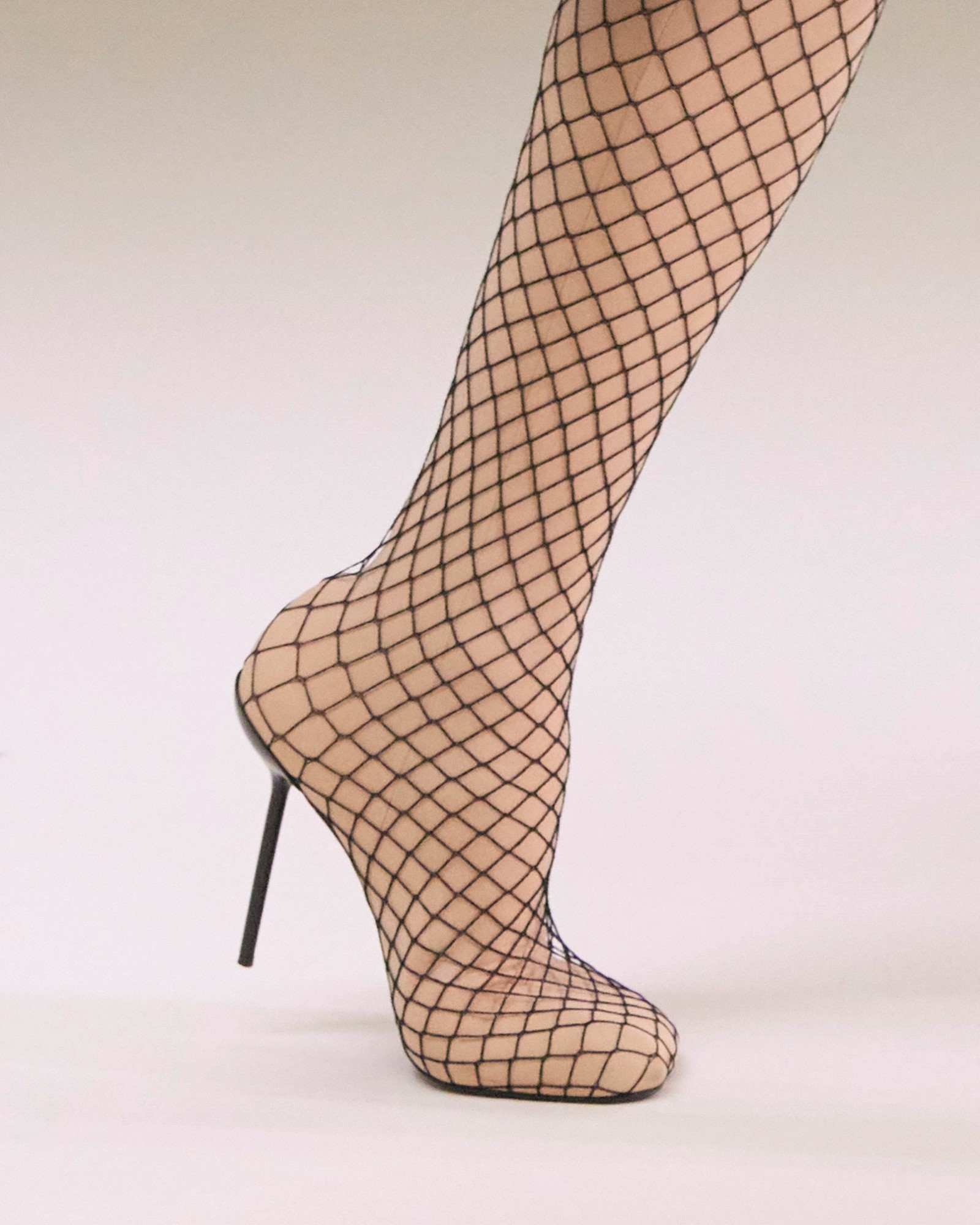

This collection marked a return to that process. “In December, when it was really hardcore for me personally, to psychologically survive this – I had a bodyguard, I had death threats – I couldn’t express myself, to actually say things … It was really hard for me – I just thought, is this my life now? I thought, I have to find something that makes me think about other stuff,” Demna says. “So I took a rail of vintage pants. I was staying in Paris, I have an apartment, with a small machine there. And I started to cut these pants up. To deconstruct, reconstruct.” He gestures to a selection of looks that, later, will come to form the core of the opening section of the Autumn/Winter 2023 Balenciaga show, made from trouser shapes reworked into tailored suits, into trench-coats, into takes on the ‘vareuse’, the loose smocks the house’s founder Cristóbal Balenciaga invented based on the garb of his father, a sailor. Demna calls it the “potato bag dress”. Here, it is made from real vintage chinos, spliced and stitched together, the fly forming a cuff opening. “I’m very manual,” Demna states.
“I was extremely frustrated. We worked for six months on the collection, and you don’t see it. The clothes are completely overshadowed by this mega-production. Which I love doing. But the clothes vanished” – Demna
In a sense, this collection was Demna’s return to the values that characterise both himself as a designer, and, for him, Cristóbal Balenciaga too. Balenciaga was known as a craftsman, one of the few even then who could construct a dress from scratch using their own hands. One always featured in each Balenciaga collection, in black. If you could spot it, it was the one the press said to watch, for the minute changes of the season that really mattered. Weirdly, there’s an echo in Demna’s own story – the first pieces he ever designed was a pair of trousers, he had made by a local tailor. He was six.

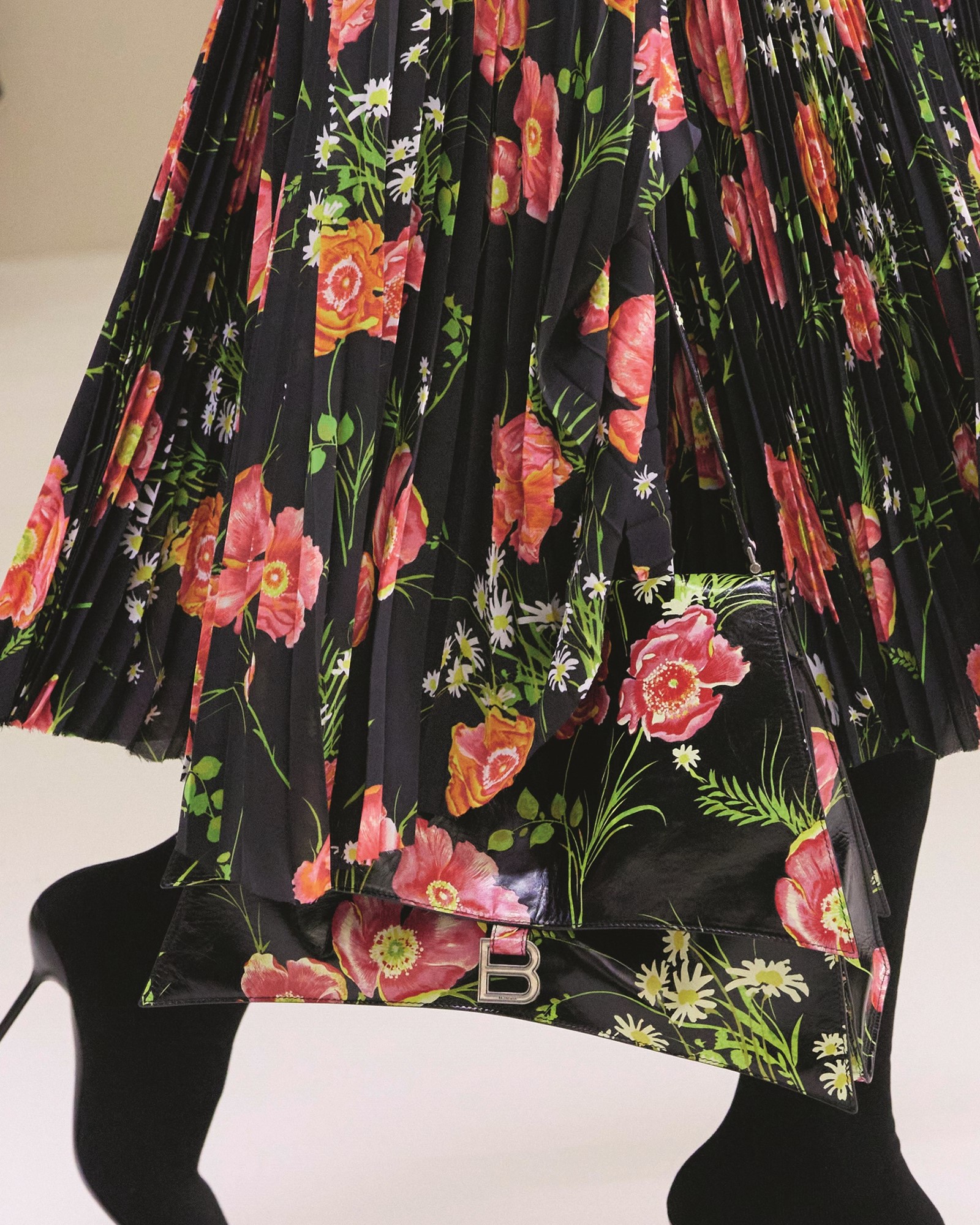
What the collection was not, Demna states, is a response to the controversy generated around the label since the Gift Shop campaign (now withdrawn) first debuted in November. “A lot of people ask me: did you do this collection as a response to the campaign drama?” Demna says. “No. We can’t do a collection in two months. We started six months ago … It was not a response to anything, it was me finding my shelter, somehow. And I realised in this process, I wasn’t thinking about all of that. And I was doing stuff that I liked.”
The opening section, connected to that rediscovery of craft, was devised since December: but it, in turn, dovetails into other ideas gestating longer. The impulse across all is the same. An exploration of technology resulted in a sequence of garments inspired by biker gear and equestrian clothes that can be inflated or deflated – they’re based on ‘airbag’ vests and jackets devised for cyclists, that inflate to protect in case of impact. Here, they morph and alter the silhouette – the back forms “a modern version of a cocoon”, which Demna reasons is very Balenciaga. “Fashion-fashion,” is also how he describes it – echoing the forward-thrusting, future-predicting styles of Balenciaga’s own silhouettes in the 50s and 60s. Which is also the origin of a silhouette of graphic, moulded round shoulders, like particularly muscular deltoids, that closed the collection. The work on this silhouette was, Demna said, almost couture quality – but “industrialisable”. They rounded day and evening dresses, especially – the final, embroidered with flayed strips of fabric glistening with beads, resembled an animal’s hide, but was drawn from a bolero in the Balenciaga archive. “With a satin bow, which is a little nod to Monsieur Balenciaga.” It also echoes the refinement and archival gestures of respect that characterised Demna’s acclaimed couture collections, shown in July 2021 and 2022 respectively.
Undoubtedly, the focus in the showroom – and, later, on the catwalk – was entirely on the clothes. Stripped of distraction, boiled to an essence. “A lot of people I’ve spoken to, also internally, are like ‘How is it going to be for you now? Are you now pressured to make things more … safe?’” Demna curls his lip. “It’s really not about that, I just cannot function like that as a designer. I need to be excited myself, about what I’m going to show. But reducing. And going to the essence.”
That essence is an essence of Demna’s aesthetic as a designer, and what Balenciaga’s style has become under him. And here it is, at the heart, about cut and construction – the architecture of clothes, not their surfaces. “It’s the first show we don’t have placed prints, sneakers,” Demna says. “It’s the first show which is really only about things that, personally, to me matter most. You will have the dresses, you will have the tailoring. I didn’t want it to be a sum-up, but I wanted it to kind of represent a lot of things that I do.”
But, undoubtedly, there is a big statement here, even if Demna did not intend it as such. That statement is that, perhaps, its time for people generally to move away from the notion of the creative director – the head overseeing content across a multitude of platforms and mediums and which, by the very nature of its size and scope, means clothing is a small part of a much larger whole – and back to the notion of a fashion designer. In essence, shifting from creating an image, back to creating clothes. “I love to do set design, and I don’t mind doing campaigns … but what about clothes?” Demna states. “This is my true value. This is why I do this.”

